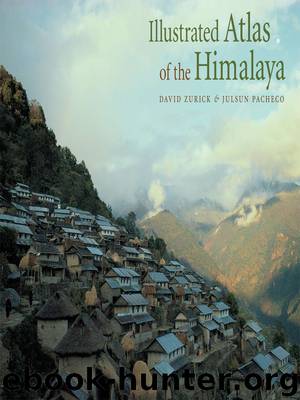Illustrated Atlas of the Himalaya by Zurick David; Pacheco Julsun;

Author:Zurick, David; Pacheco, Julsun;
Language: eng
Format: epub
Publisher: University Press of Kentucky
HIMALAYA: SOIL CLASSIFICATION
The agricultural productivity of land is closely tied to soil type. Soil formation is a product of the weathering of parent material, or bedrock, and the addition of organic matter. Meanwhile, heavy rainfall on steep slopes erodes the soil much faster than it is created. Himalayan farmers, in turn, alter the composition and fertility of soils by adding compost and manure. The soil classifications in the map follow the groupings determined by the United Nations Food and Agriculture Organization.
Due to the geographic diversity of the Himalaya, as well as to the skewed distribution of people and settlements, the amount of land used for agriculture differs from place to place in the mountains. In the western Himalayan region of Ladakh, where agriculture is possible only under irrigation, less than 2 percent of the land is farmed. Livestock grazing is important in this arid zone, taking full advantage of the seasonal pastures. In Sikkim, the proportion of farmland increases to 10 percent (or closer to 30 percent if we exclude the highest elevations, where agriculture simply is not possible due to year-round cold temperatures). Some of the lowest amounts of land under cultivation are found in the eastern Himalaya. Arunachal Pradesh reports less than 5 percent of its area devoted to farmland. Overall, the amount of agricultural land in the Indian Himalaya is about 10 percent of the total area. Bhutan devotes 16 percent of its land to agriculture of some kind (including pastureland, which accounts for up to 12 percent of the total agricultural holdings), and in Nepal, which exhibits some of the highest population-farmland densities, cropped land alone accounts for more than 17 percent of the country's total area.
HIMALAYA: CROPLAND DISTRIBUTION
The farming systems in the Himalaya reflect environmental conditions as well as cultural systems of adaptation. Shifting cultivation is common in the eastern sector. The low and middle hills of the central and western regions support predominantly mixed grain cultivation. The high mountains are used primarily for livestock grazing.
Download
This site does not store any files on its server. We only index and link to content provided by other sites. Please contact the content providers to delete copyright contents if any and email us, we'll remove relevant links or contents immediately.
China Rich Girlfriend by Kwan Kevin(4287)
The Silk Roads by Peter Frankopan(4268)
Annapurna by Maurice Herzog(3295)
Full Circle by Michael Palin(3268)
Hot Thai Kitchen by Pailin Chongchitnant(3210)
Okonomiyaki: Japanese Comfort Food by Saito Yoshio(2625)
The Ogre by Doug Scott(2501)
City of Djinns: a year in Delhi by William Dalrymple(2433)
Photographic Guide to the Birds of Indonesia by Strange Morten;(2407)
Vietnam, Cambodia, Laos & Northern Thailand by Lonely Planet(2315)
Tokyo by Rob Goss(2288)
Tokyo Geek's Guide: Manga, Anime, Gaming, Cosplay, Toys, Idols & More - The Ultimate Guide to Japan's Otaku Culture by Simone Gianni(2239)
Everest the Cruel Way by Joe Tasker(2132)
Discover China Travel Guide by Lonely Planet(2113)
Iranian Rappers And Persian Porn by Maslin Jamie(2093)
China (Lonely Planet, 11th Edition)(2032)
Lonely Planet China(2026)
China Travel Guide by Lonely Planet(1991)
Top 10 Dubai and Abu Dhabi by DK Travel(1986)
